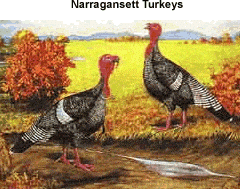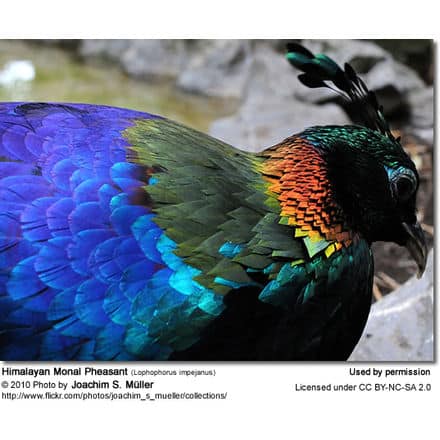Narragansett Turkey (Meleagris gallopavo)
The Narragansett turkey is named for Narragansett Bay in Rhode Island, where the variety was developed.
It descends from a cross between native Eastern Wild turkeys and the domestic turkeys (probably Norfolk Blacks) brought to America by English and European colonists beginning in the 1600’s.
Improved and standardized for production qualities, the Narragansett became the foundation of the turkey industry in New England.
Though it was valued across the country, it was especially important in Rhode Island and Connecticut.
The American Poultry Association recognized the Narragansett in 1874.
According to an 1872 account, it was not uncommon to find flocks of one to two hundred birds, the product of a breeder flock of a dozen hens. Little supplemental feed was given to the turkeys; instead they ranged for grasshoppers, crickets, and other insects.
Farmers raising the turkeys were aware of the benefits of genetic selection and raised young toms that weighed between 22-28 pounds and hens that were 12-16 pounds.
While the Narragansett was never as popular as the Bronze variety, it was widely known in the Midwest and mid Atlantic States as well as in New England.
Interest in the Narragansett began to decline in the early 1900s as popularity of the Standard Bronze grew.
The Narragansett was not used for commercial production for decades until the early 21st century, when renewed interest in the biological fitness, survivability, and superior flavor captured consumer interest and created a growing market niche.
The Narragansett color pattern contains black, gray, tan, and white. Its pattern is similar to that of the Bronze, with steel gray or dull black replacing the coppery bronze. White wing bars are the result of a genetic mutation which removes the bronze coloration and is not known outside the United States.
The Narragansett’s beak is horn colored, its head is red to bluish white and its beard is black. The shanks and feet are salmon colored.
The standard weight for young hens is 14 pounds and toms is 23 pounds.
Since, however, the Narragansett has not been selected for production attributes, including weight gain, for years, many birds may be smaller than the standard.
Careful selection for good health, ability to mate naturally, and production attributes will return this variety to its former stature.
Narragansett turkeys have traditionally been known for their calm disposition, good maternal abilities, early maturation, egg production, and excellent meat quality.
As recently as 50 years ago, they were well regarded for production qualities.
This historic variety, unique to North America, merits evaluation for production in sustainable agriculture systems. The Narragansett turkey would make a useful and beautiful addition to the family farm.
Status: Threatened
Breed clubs and associations:
American Livestock Breeds Conservancy, PO Box 477, Pittsboro, NC 27312, (919) 542-5704.
All American Turkey Growers Association, Danny Williamson, secretary-treasurer, 3441 Mustang, Tampa, KS 67483,
(785)-965-2628
American Poultry Association, PO Box 306, Burgettstown, PA15021, merpoultryassn.com
Society for the Preservation of Poultry Antiquities, Dr. Charles R.H. Everett, secretary, 122 Magnolia Lane, Lugoff, SC 29078,




